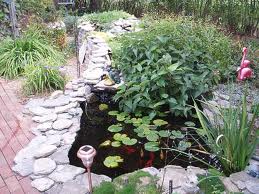






“I have just moved into a house with an overgrown concrete garden pond. Can you please advise me of the best way of dealing with the problem? I would like to start the whole thing again.”
An overgrown pool can only be cleaned out satisfactorily, and some of the plants salvaged for replanting, during spring or early summer. If you are not concerned about saving any of the plants, the work can be undertaken at any time. The first task is to reduce the water level sufficiently so that you can work comfortably in the pool. Normally, using a hosepipe to syphon out the water is the best way of doing this. Do not remove too much water, as fish may be lurking among the plants, and you may not come across them until some of the plants are removed. Indeed, throughout this process, the fish will be at risk of being damaged. However, little can be done to protect them, except to take great care when lifting the plants and to be aware of their possible presence.
Once the plants have been removed, drain the pool completely. Any remaining fish will be found in the muddy mess that always settles on the bottom. Remove them carefully, placing them in buckets of clean water in a cool place, well out of the sun. Exposing them to warmth is likely to cause stress and even death. To make them feel at home, and provide a little cover, add a handful of submerged aquatic plants to each bucket.
The plants that have been removed should be left as they are until you are ready to replant them. Marginal aquatics are best placed in clumps on a piece of thick polythene and put in a corner of the shed or garage. Waterlilies can have all their leaves cut off and the rootstocks submerged in buckets of water. Submerged aquatics can be gathered together and placed in a polythene hag with the top securely fastened and left for several days without coming to any harm.
Having removed the plants and fish from the pond, scrub it thoroughly to remove algae and any other extraneous matter. Leave it to dry out, and check that it is intact and there are no signs of leaks or fractures, before refilling with water.
When replanting, choose only the best plants from the collection that has been removed. It may be better to discard the more invasive species. In any event, take only the vigorous outer shoots from a group, and do not attempt to plant large clumps back into the pool. These rarely grow away as quickly as young growths. Moreover, by using such small pieces, it will be possible to wash them completely clean, removing the possibility of reintroducing troublesome pests like the great pond snail.
Irrespective of how the pond was planted previously, it is wise to use aquatic planting containers. These may not necessarily provide complete control of invasive species, but with a little careful management, they will contain the plants and can prevent the sort of mess that you inherited from occurring again. If the plants have started to grow vigorously, cut them back hard at planting time. This will encourage vigorous stable growth.
Leave the plants to establish for four or five weeks before reintroducing the fish. If you put them hack sooner, they will disturb the plants and cloud the water. While they are out of the pool, ensure that they are kept cool and in clean water, and fed regularly with a good-quality fish food.
“I have inherited a pool that is in an unsatisfactory position, being partially shaded by trees. It is made from a strong pool liner, which looks to be in good condition. I would like to empty the pond and re-install the liner in another part of the garden, but I am not sure how to do this.”
It is not impossible to move a pool liner successfully, but it can be quite difficult, and you should he aware of the potential problems before you attempt the task. First, you need to be fairly certain that the pool liner is intact. If the pool is holding water and the liner is made from rubber or low-density polyethylene, there is a chance of success. If it is of another, cheaper, material, attempting removal is likely to be a waste of time.
Assuming that all the plants are growing in containers, it will be a simple matter to remove them and pump out the water, along with the accumulated silt on the floor of the pool. Be sure to remove all the fish and ramshorn snails first. If the liner is covered with soil, removing it without causing damage will he almost impossible. In this situation, the only satisfactory method is to agitate the soil until it becomes a slurry, then to pump this out with a sludge pump. However, the expense of hiring the pump is likely to outweigh the cost of buying a new liner in the first place, which will almost certainly be the better alternative.
If you are able to remove the liner successfully, remember that it will restrict the size and configuration of the new pool. It is always easier to create an excavation that fits into the garden landscape, then purchase a liner to fit, rather than try to make a pool of pleasing configuration from a liner that limits its size, shape and depth.
Copyright © www.100flowers.win Botanic Garden All Rights Reserved